Patan
The study and the translation of Jaina scriptures by western scholars has a history of almost two hundred years. Understandably, this long preoccupation with written words led to a dry and unexciting, even grim picture of Jainism; a portrait that is still perpetuated by editors of books on the world’s religions as well as by writers of tourist guides.
For those of us who are not happy with this harsh evaluation, it is a welcome change to chance upon a personal observation like the one in the above prefix made by a member of a new generation of scholars. At long last, prolonged fieldwork is to become an important part in the study of this widely undervalued religion. The ‘happy people’, referred to by John E. Cort in his published Ph. D. dissertation, are the Jainas of Patan, North Gujarat.
The best known Indian of our time, Mahatma Gandhi, was a Gujarati by birth. As to the rulers of Gujarat, they were mostly Rajputs from neighbouring regions and, after the founding of Ahmedabad, Muslim sultans of foreign descent. Long before that, from around 300 BC, Gujarat was part of the Maurya empire whose capital was Pataliputra (now Patna in Bihar).
A list of fourteen edicts, cut into a boulder near Junagadh at the order of Ashoka, the last great king of the Maurya dynasty, can be taken as a testimony of the presence of both Buddhism and Jainism in Gujarat during that remote time.
Still further back, there lived in Gujarat the legendary Shri Krishna as well as Neminatha, the twenty-second Jaina Tirthankara. The two, it is believed, were related to each other, but both were born outside Gujarat. Still, it can truly be said that Gujarat has produced great personalities in the realms of intellectualism, spiritual learnedness and asceticism, and it attracted, which is equally noteworthy, rulers who were prepared not merely to tolerate men of learning and ethical stead- fastness, but to have them in their courts as counsellors.
One such ruler, king Jayasimha Siddaraja of the Solanki (also Chaulukya) dynasty, who reigned from 1094-1143, had the famous Jaina writer-monk Hema- chandra (1088-72) in his court, though he himself was a worshipper of Shiva. Under Kumarapala, Siddaraja’s immediate successor, who ruled for thirty-two years (until 1175) and who retained the counsel of Hemachandra, many Jaina temples were erected, at places like Shatrunjaya, Girnar, Taranga Hill, Kumbharia and Mt. Abu.
The capital of the Solanki kings was Anahilvad Patan, now simply Patan, then ranked as one of the finests cities on the Indian subcontinent (there is another Patan near Somnath in the south).
Of the royal glory, architecturally, little has survived. But the Jainas of Patan (then made up of both Shvetambaras and Digam- baras, but since the mid-twelfth century only of Shvetambaras), have managed to survive all vicissitudes in good numbers The last exodus, a voluntary one, started after Independence when many Jainas of Patan and other places in Gujarat decided to settle in Bombay.
About all of these migrants seem to have retained their religion and language. In his book Liberation and Wellbeing a Study of the Svetambar Murtipujak Jains of North Gujarat (see bibliography) John E. Cort lists a number of Jaina religious, social and charitable institutions found in present-day Patan, some of them having a long history behind them.
On the way to Patan, Mahesena, a city 93 km north of Ahmedabad, offers itself as a place of sojourn. Before entering this city, the motorized traveller from Ahmedabad is greeted by a new temple built in traditional style and situated in an elevated position. The Jina in its sanctum measures 3.68 metres in height. Within Mahesena city there are fourteen Jaina shrines, and among them, located in the main market- place, an old temple sacred to Parshvanatha.
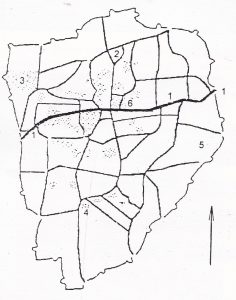 Patan (the figures were prepared by Arthur Duff, courtesy John E. Cort)
Patan (the figures were prepared by Arthur Duff, courtesy John E. Cort)
Shaded Areas=Traditional Jaina Neighbourhood
1-Main Bazar
2-Panchasar Complex 3-Salvi Vado
4-Rajka Vado
5- Samali Parshvanath 6- Sagar Upashray Temple
Area around Panchasar Temple.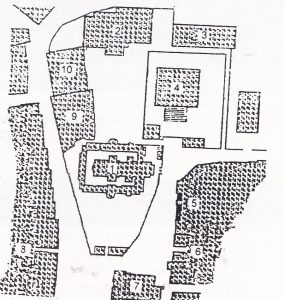
1-Panchasar Parshvanatha Temple
2-Temple Complex comprising five Shrines
3-Panchar Dharmashala
4-Hemachandra Institute and Library
5-Quarters reserved for Monks
6- Astapad Dharmashala and Temple
7-Quarters reserved for Nuns
8-Dharmashala and Parshvanatha Temple
9- Vardhman Tap Ayambilshala
10-Upashray and Manibhadra Vir Shrine
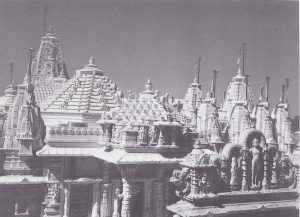 Pan, Panchalar Parshvanatha Temple Rebuilt in the sixteenth seventeenth century, aller it was devastated by Mailin invaders. According to Shree 10 Jain Tirth Darshanawall a recent book
Pan, Panchalar Parshvanatha Temple Rebuilt in the sixteenth seventeenth century, aller it was devastated by Mailin invaders. According to Shree 10 Jain Tirth Darshanawall a recent book
in Gujarati with short English translations, “There are 84 big temples and 134 shrines in 55 streets in Patin
Hemachandra Institute and Library, Pan Palm-leaf manuscripts, selected for preservative measures.
measures.
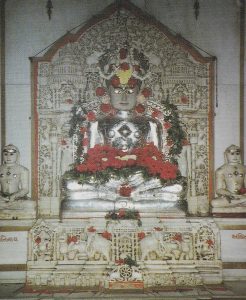 Patan. The presiding Jins in the Panchasar Parshvanatha Temple Clad like a king for the occasion of an important festival White marble, height 12 m
Patan. The presiding Jins in the Panchasar Parshvanatha Temple Clad like a king for the occasion of an important festival White marble, height 12 m
Portrait of Acharya Hemachandra (1088- 117) in the ame-nom of the Institute named after him. Hemachandra, author of many lested works, was credited with the epithet Omniscient One of the Kali Yuga He was not a recluse but a respected adviser se two successive Patah kings One of his literary compositions, entitled Yoga-ahara, which can be called a Treatise of Behaviour he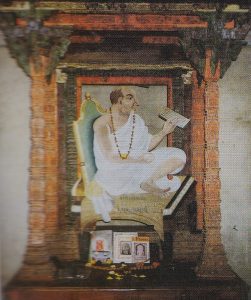 specifi cally, directed at Kumarapala, the second niler he served. His aim was to convince the young king of the beneficiary tenets of Jaina life.
specifi cally, directed at Kumarapala, the second niler he served. His aim was to convince the young king of the beneficiary tenets of Jaina life.
He largely succeeded. Under the reign of Kumars pala, Gujarat came close to being an exemplary Jaina kingdom Seen from this angle, it looks plausible that a man like Mahatma Gandhi was born in this state centuries later.
